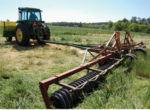Advertise Follow Us
Articles by Mark Parker
3 No-Tillers Honored for Their Responsible Nutrient Management Practices
Maryland, North Dakota and Pennsylvania growers share their efficient, effective fertility practices with no-tillers at the National No-Tillage Conference.
Read More
Yellow Field Peas Could Boost No-Till Profits In High Plains
Yellow field peas provide High Plains no-tillers with an excellent wheat transition crop that helps build soil quality and, with recent market developments, have the potential for profitability.
Read More
Yellow Field Peas Could Boost No-Till Profits In High Plains
Yellow field peas provide High Plains no-tillers with an excellent wheat transition crop that helps build soil quality and, with recent market developments, have the potential for profitability.
Read More
Yellow Field Peas Could Boost No-Till Profits In High Plains
Yellow field peas provide High Plains no-tillers with an excellent wheat transition crop that helps build soil quality and, with recent market developments, have the potential for profitability.
Read More
Killing The Most Popular Cover Crops — The Right Way
Effective termination of cover crops is essential if no-tillers are to get the best results from their seeding and establishment efforts.
Read More
On Trial: Finding The Best Closing Wheel For No-Till
Early research results from a Beck’s Hybrids study indicate no-tillers may have better alternatives than traditional rubber closing wheels, particularly when planting conditions turn out to be less than ideal.
Read More
Fertility, Covers, Precision Inputs Form Complete No-Till Package
Bill Murr leverages the soil-building benefits of no-till with strategic nutrient, weed and disease management on his 3,400-acre farm in northeast Kansas.
Read More
No-Till, Covers Make CRP Acres Protected And Productive Again
Missouri farmer Jerry Morris says no-till and cover-crop mixes helped him put CRP acres back into crop production and keep his sloping fields from suffering erosion.
Read More
No-Till, Covers May Hold Key To Easing Nutrient-Loading Issues
The success of no-till, cover crops and nutrient stewardship in Indiana’s Eagle Creek Watershed could serve as a blueprint for preserving farmland productivity without sacrificing water quality.
Read More












